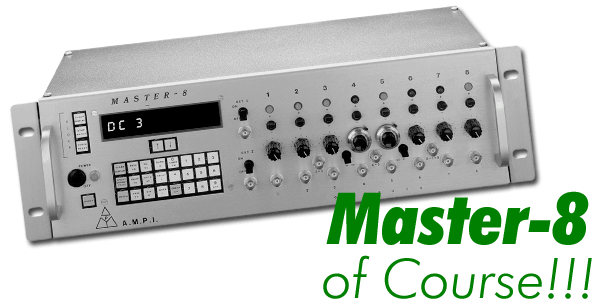
Examples
What makes Master-8 the best pulse stimulator?

Because:
Master-8 costs about the same as 2-channel stimulators...
...but it can do so much more!
Example 1: Precise accuracy of timing
Stimulation by PC:
A PC operating system is not designed to generate highly precision timing because its CPU is prioritized for other functions. Making the PC output timing more precise by adding boards and software is expensive.
2-channel stimulators:
There is a 2-channel stimulator which states in its instruction manual that because it uses triggered circuits, it does not have the capacity to deliver precise timing if operated above a 50% duty cycle.
Master-8 is a reliable stimulator:
Each channel uses its own internal digital clock.
This enables precise accuracy of timing even with high duty cycles.
Example 2: Communication with a PC
Other stimulators:
There are stimulators that are unable to communicate with a PC.
Master-8 is a stand-alone unit, yet can download/upload experiments and be controlled by a PC via its USB interface.
Example 3: The 2-channel stimulators cannot produce the following simple pattern
Master-8 does it easily.

2-channel stimulators cannot handle this because more than 2 channels are required for this pattern.
Master-8: All 8 channels can be internally connected to each other, in all possible combinations.
Other stimulators cannot repeat the sequence every 2 minutes because their longest interval time is less than 2 min.
Master-8 has a wide time range: interval and duration times - from 40 microsec. to over an hour.
Nor can other stimulators repeat the sequence even every 1 minute, because their longest interval times are fixed to 100 sec., 50 sec., 33.3 sec… (0.01 PPS, 0.02 PPS, 0.03 PPS, etc.).
Master-8 can be set to any desired interval time.
Example 4: Modifying parameters 'on the fly'
The 2-channel stimulators: It is extremely difficult to modify the time parameters on the fly, e.g. try to alter the delay time from 12.34 msec. to 56.78 msec., then reset it to 12.34 msec.
If this is done while stimulating, it results in unwanted intermediate parameters.
Master-8: You can modify parameters on the fly – simply press the arrows, or key in the new parameter.
Other stimulators: It is very inconvenient to make the above time changes using stimulators where you modify the time by turning thumbwheels.
Master-8: Simply key in the new parameter - no need to turn thumbwheels.
Example 5: TRAINS of pulses
Some stimulators are unable to deliver TRAINS of 5 pulses or more at 0.04 PPS, since their longest
TRAIN-DURATION is 100 sec.
Master-8 can do it easily, as it has a wide time range.
Other stimulators cannot provide sequences of a first basic fixed TRAIN followed by second variable TRAINS (S1 and S2 TRAINS).
Master-8 can provide these TRAINS, as it offers special flexibility when using TRAINS of pulses.
Master-8 can do all of these and much more:
-
Master-8 uses digital controls to enable precise accuracy of timing.
-
Master-8 delivers monophasic, biphasic, twin or twin-biphasic pulses.
-
It is easy to save and switch between 8 sets of stimulating patterns s1 to s8,8 channels for each pattern.
-
Master-8 is a stand-alone unit, but can also be controlled by a PC via a USB interface.
-
Master-8-vp model provides increment/decrement voltage steps: fixed or variable steps.
Master-8, Master-9, ISO-Flex, ISU, s88, sd9, stimulator, pulse stimulator, pulse generator, Isolation unit, optogenetic stimulations, neurophysiological stimulation
